

Colonization of Titan. Surface and atmospheric composition[edit] According to Cassini data from 2008, Titan has hundreds of times more liquid hydrocarbons than all the known oil and natural gas reserves on Earth.
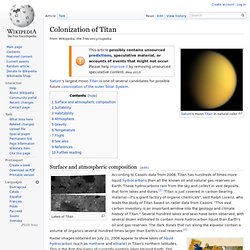
These hydrocarbons rain from the sky and collect in vast deposits that form lakes and dunes.[1] "Titan is just covered in carbon-bearing material—it's a giant factory of organic chemicals", said Ralph Lorenz, who leads the study of Titan based on radar data from Cassini. “This vast carbon inventory is an important window into the geology and climate history of Titan.” Several hundred lakes and seas have been observed, with several dozen estimated to contain more hydrocarbon liquid than Earth's oil and gas reserves. Ocean. This animation uses Earth science data from a variety of sensors on NASA Earth observing satellites to measure physical oceanography parameters such as ocean currents, ocean winds, sea surface height and sea surface temperature.
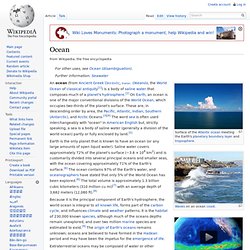
An ocean (from Ancient Greek Ὠκεανός, transc.
Swa astronomy ss objects. Farbauti (moon) Farbauti (/fɑrˈbaʊti/ far-BOW-tee) or Saturn XL (provisional designation S/2004 S 9) is a natural satellite of Saturn.
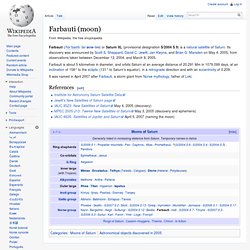
Its discovery was announced by Scott S. Sheppard, David C. Jewitt, Jan Kleyna, and Brian G. Marsden on May 4, 2005, from observations taken between December 12, 2004, and March 9, 2005. Farbauti is about 5 kilometres in diameter, and orbits Saturn at an average distance of 20,291 Mm in 1079.099 days, at an inclination of 158° to the ecliptic (131° to Saturn's equator), in a retrograde direction and with an eccentricity of 0.209.
S/2004 N 1. Lunar meteorite. List of minor planets. This is a list of numbered minor planets in the Solar System, in numerical order.
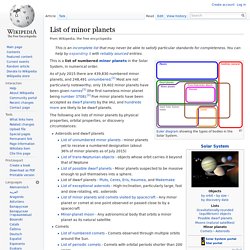
The following are lists of minor planets by physical properties, orbital properties, or discovery circumstances: Numbering and naming conventions[edit] Total, numbered, and named minor planets from 1995 to 2014. After discovery, asteroids generally receive a provisional designation (such as "1989 AC"), then a sequential number (such as 4179), and finally (optionally) a name (such as "Toutatis"), in that order.
In modern times, an asteroid receives a sequential number only after it has been observed several times over at least 4 oppositions[3]. Moonlight. A photograph taken by moonlight with an exposure time of fifty minutes.

Illumination[edit] The color of moonlight, particularly near full moon, appears bluish to the human eye compared to most artificial light sources. This is because of the Purkinje effect - the light is not actually tinted blue, and although moonlight is often referred to as "silvery" it has no inherent silvery quality. The Moon's albedo is 0.136,[3] meaning only 13.6% of sunlight incident on the Moon is reflected. Folklore[edit] Planetshine. The phenomenon of planetshine occurs when reflected sunlight from a planet illuminates the night side of one of its moons.

Typically, this results in the moon's night side being bathed in a soft, faint light. The best known example of planetshine is earthshine, which can be seen from Earth when the Moon is a thin crescent. Genesis Rock. The Genesis Rock The Genesis Rock is a sample of Moon rock retrieved by Apollo 15 astronauts James Irwin and David Scott in 1971 during their second lunar EVA.

It is currently stored at the Lunar Sample Laboratory Facility in Houston, Texas. Chemical analysis of the Genesis Rock indicated it is an anorthosite, composed mostly of a type of plagioclase feldspar known as anorthite.
Dwarf planet. Pluto in approximate true colour based on Hubble Space Telescope albedo data.
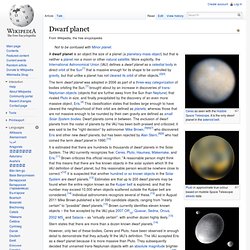
Centaur (minor planet) Centaurs are small Solar System bodies with a semi-major axis between those of the outer planets.
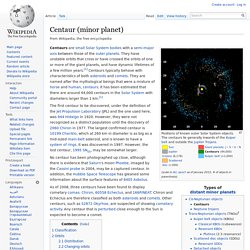
They have unstable orbits that cross or have crossed the orbits of one or more of the giant planets, and have dynamic lifetimes of a few million years.[1] Centaurs typically behave with characteristics of both asteroids and comets. They are named after the mythological beings that were a mixture of horse and human, centaurs. It has been estimated that there are around 44,000 centaurs in the Solar System with diameters larger than 1 km.[1] The first centaur to be discovered, under the definition of the Jet Propulsion Laboratory (JPL) and the one used here, was 944 Hidalgo in 1920. Minor planet. List of minor planets. Ceres (dwarf planet) From Earth, the apparent magnitude of Ceres ranges from 6.7 to 9.3, and hence even at its brightest it is too dim to be seen with the naked eye except under extremely dark skies.
Piazzi's book "Della scoperta del nuovo pianeta Cerere Ferdinandea" outlining the discovery of Ceres, dedicated the new "planet" to Ferdinand I of the Two Sicilies One of the astronomers selected for the search was Giuseppe Piazzi at the Academy of Palermo, Sicily. Peak of eternal light. A peak of eternal light (PEL) is a point on a body within the Solar System which is always in sunlight.
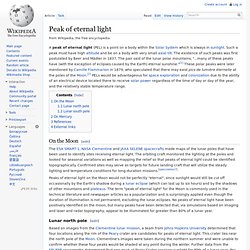
Such a peak must have high altitude and be on a body with very small axial tilt. The existence of such peaks was first postulated by Beer and Mädler in 1837. Galilean moons. The four moons were discovered in either 1609 or 1610 when Galileo made improvements to his telescope, which enabled him to observe celestial bodies more distinctly than had ever been possible before.[1] Galileo's discovery showed the importance of the telescope as a tool for astronomers by proving that there were objects in space that cannot be seen by the naked eye. More importantly, the incontrovertible discovery of celestial bodies orbiting something other than Earth dealt a serious blow to the then-accepted Ptolemaic world system, or the geocentric theory in which everything orbits around Earth.
Galileo initially named his discovery the Cosmica Sidera ("Cosimo's stars"), but the names that eventually prevailed were chosen by Simon Marius. Marius discovered the moons independently at the same time as Galileo, and gave them their present names, which were suggested by Johannes Kepler, in his Mundus Jovialis, published in 1614. Areostationary orbit. An areostationary orbit (abbreviated ASO) is a circular areosynchronous orbit in the Martian equatorial plane about 17,000 km (11,000 mi) above the surface, any point on which revolves about Mars in the same direction and with the same period as the Martian surface.
Areostationary orbit is a concept similar to Earth's geostationary orbit. Although to date, no artificial satellites have been placed in this orbit, it is of interest to some scientists foreseeing a future telecommunications network for the exploration of Mars.[1] The proposed Mars One mission includes a communications system featuring amongst others things an areostationary satellite.[2] Super-Dense Water. Lunar outpost (NASA) Concept art from NASA showing astronauts entering a lunar outpost. (2006) S/2004 N 1.